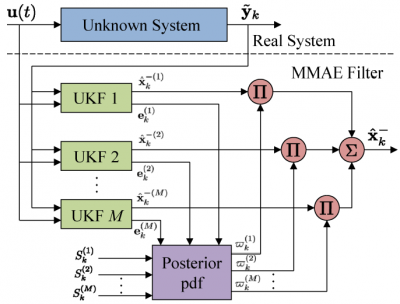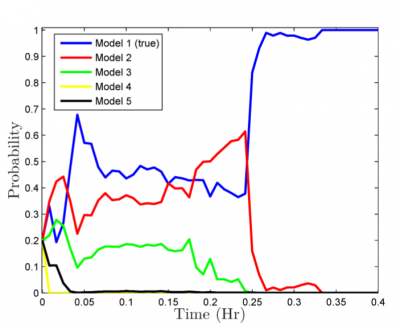Space Situational Awareness
From ANCS Wiki
Abstract
A new method is discussed, based on an unsupervised learning state variable method that uses a multiple-model adaptive estimation approach to determine the most probable shape and other intrinsic features of a space object in orbit among a number of candidate models while simultaneously recovering the observed resident space object’s inertial orientation and trajectory. Multiple-model adaptive estimation uses a parallel bank of filters to provide multiple space object state estimates, where each filter is purposefully dependent on a mutually unique resident space object model. Estimates on the conditional probability of each model given the available measurements are provided from the multiple-model adaptive estimation approach. Each filter employs the Unscented (or Sigma-Point) estimation approach, reducing passively-collected electro-optical data to infer the unknown state vector comprised of the space object inertial-to-body orientation, position and their respective temporal rates. Each hypothesized model results in a different observed optical cross-sectional area. The effect of solar radiation pressure may be recovered from accurate angles-data alone, if the collected measurements span a sufficiently long period of time so as to make the non-conservative mismodeling effects noticeable. However, for relatively short data arcs, this effect is weak and thus the temporal brightness of the resident space object can be used in concert with the angles data to exploit the fused sensitivity to both space object characteristics and associated trajectory, the very same ones which drive the non-conservative dynamic effects. Recovering these characteristics and trajectories with sufficient accuracy is shown in this proposal, where the characteristics are inherent in unique space object models.
Objectives

Figure 1 MMAE Process |

Figure 2 MMAE with Five RSO Models |
The objectives of this work are to research and develop methods of detecting, tracking, characterizing, and discriminating space objects (RSOs) to support Space Control and Space Situational Awareness (SSA), which requires the tracking, identifying, and predicting of future intentions, actions, and positions of RSOs with known accuracy and precision. To meet these objectives advanced estimation strategies, i.e. multiple model adaptive estimation, will be employed to reduce astrometric and photometric data simultaneously to recover the orbital and physical characteristics for one or more RSOs. Initially, simulated data for a cluster of controlled spacecraft will be used to prove the concepts, with increasingly more realistic scenarios being developed. Actual optical observational data (astrometry and multi-band temporal photometry) will be utilized to test the utility of these techniques in estimating (recovering) RSO orbit and physical states in near-real time. This work plan leverages a high value data set of multi-band temporal photometry collected as part of GEO cluster characterization campaign that will be used in the research outlined in this proposal. As the techniques mature, uncontrolled RSOs (i.e. near-GEO debris) will be simulated and observed.
Research
Shape estimation is an important issue in the observation of RSOs, because the shape influences the dynamics of the object and may provide valuable information on the object’s origin or intent. There exists a number of methods for estimating the shape of an object. These methods vary in the sensor type used, technique used to resolve shape, and effective ranges for proper shape resolution. Radar-based methods have been extensively used for shape estimation, which include radar cross-sectioning approaches and range Doppler interferometry. These techniques were first developed in the field of planetary radar astronomy to estimate the shape of natural satellites, but then were later applied to the imaging of artificial Earth orbiting satellites. These methods are limited by the RSO size and distance. RSOs can be imaged in low-Earth orbits that are much larger in the dimension than the wavelength of the radar signal. To image RSOs smaller and farther than these ranges requires very powerful radar devices, making these economically unattractive.
Laser radar-based (LADAR) methods have also been used to estimate the shape of RSOs. LADAR provides a three-dimensional scan of the object, which can resolve shape geometry at ranges of 1 km, returning a cloud of points of the measured relative position of an object. DiMatteo [1] used LADAR scans to perform a least squares fit of the LADAR returns to previously assembled point cloud models to estimate the shape of an RSO. Licther [2] developed a filter approach to simultaneously estimate dynamic states, geometric shape, and mass model parameters of a satellite using multiple observations with LADAR sensors. In Ref. [2] a probabilistic map of the RSO is constructed using a sensor uncertainty model and the dynamics experienced by the RSO to estimate the shape of the same. Using well modeled dynamical relationships of the RSO provides enhancements to be implemented within a filter architecture in this shape estimate approach.
Resolved images have been used to estimate the size and shape of satellites as well. These methods work either directly with the pixels of the images or are used to identify features of the RSO. Features, such as corners, edges and markers, are located and tracked temporally to estimate higher level motion and the structure of the ridged body. The feature-based methods rely on continuously identifying and tracking higher level traits of the RSO by using a Kalman filter to estimate feature location and motion parameters. Although these methods estimate the motion of features they do not by themselves provide a detailed estimate of the shape of the object and only give a sparse set of feature points of the object. Pixel-based methods rely on pixel-level information, and use the shading, texture and optical flow of the images to estimate the shape of an object at each time step using a monocular camera. Since these methods rely on pixel-level computations they typically involve very high-dimensional states and therefore are very computationally expensive. These methods are also very sensitive to pixel-level detail and are easily corrupted by unpredictable light intensities, reflective material and wrinkled surfaces. They require high resolution of the object to resolve meaningful shape estimates, and therefore are only effective for space-based sensors and or high resolution ground-based telescopes.
Some powerful ground-based telescopes, like the Air Force Maui Optical and Supercomputing (AMOS) site Advance Electro-Optical System (AEOS), can resolve RSOs such as Hubble Space Telescope and the International Space Station to very high detail, but most objects are too small and or too distant (making them dim) to lend themselves to ground-based resolved imaging. For example operational RSOs in geosynchronous orbits and “micro” and “nano” satellites are too small to be resolved using ground-based optical observations. Angular measurements of these smaller objects are still made to provide their coordinates as they traverse the sky. Although the amount of light collected from these objects is small, information can still be extracted from these data which can be used to resolve their shapes.
Light curves (the RSO temporal brightness) have also been used to estimate the shape for an object. Light curve approaches have been studied to estimate the shape and state of asteroids. Reference [3] used light curves and thermal emissions to recover the three-dimensional shape of an object assuming its orientation with respect to the observer is known. The benefits of using light curve data is that use of this approach is not limited to larger objects in lower orbits but can be applied to small and dim objects in higher orbits, such as geostationary. Here light curve data is considered for shape estimation as well as other intrinsic parameters such as material properties. Light curve data is useful because it provides a mechanism to estimate both position and attitude, as well as the respective rates.
There are several aspects of using light curve data (temporal photometry) that make it particularly advantageous for object detection, identification and tracking. Light curve data are the time-varying sensor wavelength-dependent apparent magnitude of energy (e.g. photons) scattered (reflected) off of an object along the line-of-sight to an observer. Because the apparent magnitude of the RSO is a function of its size, orientation, and surface material properties, one or more of these characteristics should be recoverable from the photometric data. This can aid in the detection and identification of an RSO after a catalog of spacecraft data with material properties is developed, and may also prove to be powerful for never-seen-before objects. Determining the material properties of an object can also give insight into its surface instrumentation and equipment, i.e. solar panels or painted aluminum.
There is a coupling between RSO attitude and non-conservative accelerations. This can be exploited to assist in the estimation of the RSO trajectory. The measurement of the apparent magnitude is a function of several RSO characteristics that are those which drive certain non-conservative forces (i.e. solar radiation pressure (SRP)). The acceleration due to SRP is modeled as function of an object’s Sun-facing area, surface properties and attitude. It has a very small magnitude compared to gravitational accelerations, and typically has an order of magnitude around 10−7 to 10−9 km/sec2, but is the dominant non-conservative acceleration for objects above 1,000 km. Below 1,000 km, drag caused by the atmospheric neutral density is the dominating non-conservative acceleration.
Attitude estimation using light curve data has been demonstrated in Ref. [4]. The main goal of this current work is to use light curve data to, autonomously and in near real-time, determine the shape and intrinsic properties of a RSO along with its attitude (rotational) and translational states. In order to accomplish this task a multiple-model adaptive estimation (MMAE) approach is used (see Figure 1); running a number of parallel Unscented Kalman filters (UKF) the MMAE approach determines the most probable shape or property of a RSO in orbit among a number of candidate models. Each filter uses a different assumed model, and the state estimate is given by the weighted sum of each filter’s estimate. The weights correspond to the conditional probabilities derived from Bayes’ rule using the likelihood information of the unknown states conditioned on the current-time measurement residual and innovations covariance.
Preliminary results for shape estimation of the approach are shown in Ref. [5]. For the development of the measured light curve data a six-faceted RSO is used. Five shapes are tested in a multiple hypothesis approach to assess the performance of the method. Results from the MMAE solution are shown in Figure 2. The solution shows that the approach is viable by identifying the correct shape. This provides a basis for optimism but much more work needs to be done. This includes: 1) using more complex shape models in the shape model bank, 2) incorporating a generalized MMAE [6] approach to obtain faster convergence rates, 3) using multiband data to improve performance, and 4) extend the work to assess the observability of estimating other intrinsic properties, such as the spacecraft material properties.
References
[1] DiMatteo, J., Florakis, D., Weichbrod, A., and Milam, M., “Proximity Operations Testing with a Rotating and Translating Resident Space Object,” AIAA Guidance, Navigation and Control Conference, Aug. 2009, AIAA-2009-6293.
[2] Lichter, M. D. and Dubowsky, S., “State, Shape, and Parameter Estimation of Space Objects from Range Images,” Proceedings of Robotics: Science and Systems, June 2005.
[3] Calef, B., Africano, J., Birge, B., Hall, D., and Kervin, P., “Photometric Signature Inversion,” Proceedings of the International Society for Optical Engineering, Vol. 6307, Aug. 2006, Paper 11.
[4] Jah, M. and Madler, R., “Satellite Characterization: Angles and Light Curve Data Fusion for Spacecraft State and Parameter Estimation,” Proceedings of the Advanced Maui Optical and Space Surveillance Technologies Conference, Vol. 49, Wailea, Maui, HI, Sept. 2007.
[5] Linares, R., Crassidis, J.L., Jah, M.K., and Kim, H., “Astrometric and Photometric Data Fusion for Resident Space Object Orbit, Attitude, and Shape Determination Via Multiple-Model Adaptive Estimation,” AIAA Guidance, Navigation, and Control Conference, Toronto, CA, Aug. 2010, AIAA Paper #2010-8341.
[6] Alsuwaidan, B.N., Crassidis, J.L., and Cheng, Y., “Generalized Multiple-Model Adaptive Estimation Using an Autocorrelation Approach” IEEE Transactions on Aerospace and Electronic Systems, Vol. 47, No. 3, July 2011, pp. 2138-2152.
